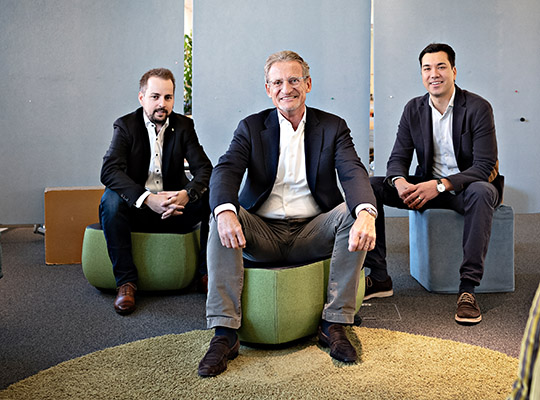Monitoring modern technologies
A successful cooperation between two disparate partners
Through a strategic alliance with Geneva-based product testing group SGS, Swisscom shows how the monitoring of grain can reach a new quality standard thanks to modern technology.
Text: David Schnapp , Images: Michele Limina , first published in NZZ
Of all the new data-driven technologies, three letters have a most promising ring to them: IoT. The magic phrase «Internet of Things» conjures up visions of futuristic worlds. But the term really just means the ability to connect all kinds of different devices, such as sensors and vehicles, to the internet with wired and wireless connections.
Several have already become commonplace, such as timers that can be controlled with smartphones. Or toothbrushes that have an app showing us how well we have cleaned our teeth, or ovens that download recipes from the internet via our home wifi network. All these things work, but ultimately they are individual solutions that are not sufficient on their own to generate business more efficiently within a larger industrial context.
In 2018, Swisscom entered a strategic partnership with Geneva-based product testing group SGS. The goal is to expand the possibilities afforded by IoT to a consistently high level of quality. Fred Herren, Senior Vice President of SGS, responsible for the Digital and Innovation divisions, sees the alliance as a game-changer.
«IoT has inspired all kinds of fantasies, but much of what has been realised so far is technology-driven and not very solutions-oriented. Most people have no real idea of how IoT can be made useful. Our background is in the traditional, physical world of product testing. IoT offers one solution, but is not the only possibility. Our approach is to integrate IoT into the real world in a way that makes sense for our customers.»
From snapshot to motion picture sequence
Julian Dömer is Head of IoT at Swisscom and works with a large team to implement international IoT projects on a large scale. «In this context, SGS approached us with the following task: currently, product testing essentially involves taking a snapshot. We want to take these images and make a film from them. By partnering with Swisscom, SGS envisages being able to report to its customers on the state of a certain object in any place and at any time. This calls for new technologies and new approaches. In the past, an SGS employee would travel to a location, test something and fill out a form. We want to use technical solutions to help simplify processes,» says Dömer of the partnership between SGS and Swisscom.
Fred Herren believes this is an important advancement in the services offered by SGS: «believes this is an important advancement in the services offered by SGS: «If we can shift from a single frame approach to making a film sequence, it will enable us to react to problems at an early stage. Today, a customer might call us in the middle of the night because they have discovered a hairline crack in a car part, for instance. We dispatch someone to look into it, production comes to a standstill and the customer loses a lot of money. If we can constantly monitor the parts, we catch yellow flags in time, allowing us to notify the customer before there is a real problem. »
«We want to integrate IoT into the real world in a way that makes sense for our customers.»
Fred Herren, SGS
The first project in the strategic partnership between SGS and Swisscom sounds rather simple: in Egypt, sensors monitor huge grain silos. When temperature, humidity or CO2 reach problematic levels, the silo manager is notified. «If we carry out monthly inspections, we lose a month each time. And the humidity inside the silo, for example, can change immensely during this time, », explains Herren.

Julian Dömer (left), Head of IoT, and Marcel Meyer (right), project manager, Swisscom, with Fred Herren, Senior Vice President SGS: the product testing group envisages being able to report to its customers on the state of certain objects in any place and at any time. ((Image: Michele Limina))
Under difficult conditions
But it’s not as simple as it sounds. First, reliable information is needed. Simply taking measurements on the surface of the grain is insufficient, according to Herren. One must ensure that the measurements go deep enough. That requires a system for collecting information and communication channels to transmit this information.
Herren puts SGS's requirements in a nutshell: «We need reliable information – and we need it fast.» Along with the physical challenges, there are technical problems as well. «A silo is basically a poor environment for wireless communication,» says IoT specialist Dömer. «And we don’t have just one silo but many – and grain isn’t exactly the most high-margin product in the world. So you have to keep a close eye on the costs for collecting and transmitting data,» explains the Swisscom manager.
This also explains why a strong alliance with SGS is needed: «Together, we recognise the challenges before someone makes a mistake. But it isn’t enough to just mount a sensor somewhere if it ends up failing in a windstorm, for example.» The point of intersection between the two very different partners companies also creates an interesting foundation. Based in Geneva, SGS is a publicly listed company with around 97,000 employees and operates in more than 120 countries around the world.
«We have to be able to adapt to any situation our customers present to us. We are implementing our first project with Swisscom in Egypt, which is not a country where you find ultra-fast 5G mobile internet. And we’re not working in Cairo, but rather in the remote countryside,» explains SGS Vice President Herren.
High-quality data
Dömer, who holds a degree in business economics, explains that the challenge for Swisscom is to implement its IoT solutions in a wide variety of countries. «Of course, we are familiar with the market here in Switzerland, but working in an African country is a completely different story. There might be a mobile network, but you can’t necessarily use it just like that,» he says. «Together with SGS, we can learn how to scale and multiply our leading solutions and understand how other markets work,» he adds.
Both Swisscom and SGS ultimately have a shared interest in the core of the respective business segment: «It’s about high-quality data,» says Marcel Meyer, Swisscom’s project leader for the partnership. «We have to ensure that our data meets SGS standards.» Meanwhile, Herren thinks that for SGS this means «that we have strong partners». This kind of partnership also involves developing mutual trust and understanding, which enables mistakes to be handled in a reasonable way. «Mistakes are always made,» says Dömer.
From a technical standpoint, IoT solutions must have completely reliable connectivity with the data sources. For example, the silos in Egypt use LoRa, or «Low Range Wide Area Network», which is highly stable, inexpensive and uses very little electricity. The next component is the cloud and here Microsoft Azure is used. «The cloud sounds really simple, but when you want to work in so many different countries, you have to deal with local regulations, which is why selecting the right platform is crucial,» explains Swisscom expert Dömer. He says it is good to work with a partner such as Microsoft, which offers a very powerful technology platform in this area. And ultimately the task is to analyse the data. For the Egypt project, the current state of the grain must be measured constantly, and here also a Microsoft solution is used. Baby steps
But Dömer is already thinking about the next phase: «Thanks to our alliance, in future SGS might be able to tell the farmers when the time is right to sell the grain, because we monitor the market and can make forecasts. And to take it even further, self-learning systems can predict precisely when is a good time to buy or sell certain commodities.» The task is to take it one step at a time, but it is always good to have an idea and plan for the future. According to Herren, the strategy of taking small steps is important, because SGS often works with clients that take a conservative approach.
«Together with SGS, we can learn how to scale and multiply our solutions.»
Julian Dömer
There are many security concerns when it comes to collecting and analysing data. «We know data has to be transmitted and stored securely,» explains IoT specialist Dömer. He adds: «Because it’s our own technology, we have a great responsibility. The benefit of working with SGS is that it monitors very closely whether security is really guaranteed. So that’s reaffirming for us as well.» The relationship between Swisscom, SGS and Microsoft has made the grain project in Egypt a pioneering achievement in many respects. Several technical solutions are being used for the first time in this form. «Many fail with these kinds of projects because they have lofty ideas, but are barely able to take the first step,» says Swisscom project manager Meyer. Dömer’s team has successfully implemented about 600 IoT projects since 2013. The next goal is to implement the new knowledge on a larger scale.
Swisscom and SGS
Two giants with differing backgrounds and expertise have joined forces. Founded in 1998, Swisscom is the leading telecommunications provider in Switzerland and one of the country’s biggest providers of IT solutions. The company has about 20,000 employees and reported CHF 11.7 billion in revenue in 2018.
Founded in 1878, SGS is an international product inspection and testing group based in Geneva, with more than 1,800 branches and laboratories and 97,000 employees in more than 120 countries. In 2018, SGS reported CHF 6.7 billion in revenue from its inspection, verification, physical testing and certification business segments.
In 2018, Swisscom and SGS entered a strategic partnership to offer consistently high quality in product tests with telecommunications and cloud solutions in the area of system integration and operation.

Newsletter
Would you like to regularly receive interesting articles and whitepapers on current ICT topics?
Recent articles on the topic:

